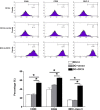Immunotherapy for Lewis lung carcinoma utilizing dendritic cells infected with CK19 gene recombinant adenoviral vectors
- PMID: 26323510
- PMCID: PMC4583529
- DOI: 10.3892/or.2015.4231
Immunotherapy for Lewis lung carcinoma utilizing dendritic cells infected with CK19 gene recombinant adenoviral vectors
Abstract
Dendritic cells (DCs) as 'professional' antigen-presenting cells (APCs) initiate and regulate immune responses to various antigens. DC-based vaccines have become a promising modality in cancer immunotherapy. Cytokeratin 19 (CK19) protein is expressed at high levels in lung cancer and many other tumor cells, suggesting CK19 as a potential tumor‑specific target for cancer immune therapy. We constructed a recombinant adenoviral vector containing the CK19 gene (rAd-CK19). DCs transfected with rAd-CK19 were used to vaccinate C57BL/6 mice bearing xenografts derived from Lewis lung carcinoma (LLC) cells. The transfected DCs gave rise to potent CK19-specific cytotoxic T lymphocytes (CTLs) capable of lysing LLC cells. Mice immunized with the rAd‑CK19-DCs exhibited significantly attenuated tumor growth (including tumor volume and weight) when compared to the tumor growth of mice immunized with rAd-c DCs or DCs during the 24-day observation period (P<0.05). The results revealed that the mice vaccinated with the rAd-CK19-DCs exhibited a potent protective and therapeutic antitumor immunity to LLC cells in the subcutaneous model along with an inhibitive effect on tumor growth compared to the mice vaccinated with the rAd-c DCs or DCs alone. The present study proposes a meaningful mode of action utilizing rAd-CK19 DCs in lung cancer immunotherapy.
Figures






Similar articles
-
Antitumor effects of murine bone marrow-derived dendritic cells infected with xenogeneic livin alpha recombinant adenoviral vectors against Lewis lung carcinoma.Lung Cancer. 2010 Jun;68(3):338-45. doi: 10.1016/j.lungcan.2009.07.007. Epub 2009 Aug 9. Lung Cancer. 2010. PMID: 19671483
-
Granulocyte-macrophage colony-stimulating factor gene-transduced tumor cells combined with tumor-derived gp96 inhibit tumor growth in mice.Hum Gene Ther. 2003 May 20;14(8):715-28. doi: 10.1089/104303403765255129. Hum Gene Ther. 2003. PMID: 12804136
-
The boosting effect of co-transduction with cytokine genes on cancer vaccine therapy using genetically modified dendritic cells expressing tumor-associated antigen.Int J Oncol. 2006 Apr;28(4):947-53. Int J Oncol. 2006. PMID: 16525645
-
New approaches to the development of adenoviral dendritic cell vaccines in melanoma.Curr Opin Investig Drugs. 2010 Dec;11(12):1399-408. Curr Opin Investig Drugs. 2010. PMID: 21154122 Free PMC article. Review.
-
The Journey of in vivo Virus Engineered Dendritic Cells From Bench to Bedside: A Bumpy Road.Front Immunol. 2018 Sep 11;9:2052. doi: 10.3389/fimmu.2018.02052. eCollection 2018. Front Immunol. 2018. PMID: 30254636 Free PMC article. Review.
Cited by
-
Dendritic Cell Vaccination in Non-Small Cell Lung Cancer: Remodeling the Tumor Immune Microenvironment.Cells. 2023 Oct 4;12(19):2404. doi: 10.3390/cells12192404. Cells. 2023. PMID: 37830618 Free PMC article. Review.
-
Dendritic cells based immunotherapy.Am J Cancer Res. 2017 Oct 1;7(10):2091-2102. eCollection 2017. Am J Cancer Res. 2017. PMID: 29119057 Free PMC article. Review.
-
Applications of mRNA Delivery in Cancer Immunotherapy.Int J Nanomedicine. 2025 Mar 17;20:3339-3361. doi: 10.2147/IJN.S500520. eCollection 2025. Int J Nanomedicine. 2025. PMID: 40125430 Free PMC article. Review.
-
Immunotherapeutic effects of TCL-E5 and TCL-E5-pulsed DCs: two novel HPV therapeutic vaccine candidates.Immunotherapy. 2025 Feb;17(3):191-199. doi: 10.1080/1750743X.2025.2478814. Epub 2025 Mar 18. Immunotherapy. 2025. PMID: 40099844
-
In vivo tracking of adenoviral-transduced iron oxide-labeled bone marrow-derived dendritic cells using magnetic particle imaging.Eur Radiol Exp. 2023 Aug 15;7(1):42. doi: 10.1186/s41747-023-00359-4. Eur Radiol Exp. 2023. PMID: 37580614 Free PMC article.
References
-
- Collins LG, Haines C, Perkel R, Enck RE. Lung cancer: Diagnosis and management. Am Fam Physician. 2007;75:56–63. - PubMed
-
- Moscatello DK, Ramirez G, Wong AJ. A naturally occurring mutant human epidermal growth factor receptor as a target for peptide vaccine immunotherapy of tumors. Cancer Res. 1997;57:1419–1424. - PubMed
-
- Heimberger AB, Crotty LE, Archer GE, et al. Epidermal growth factor receptor VIII peptide vaccination is efficacious against established intracerebral tumors. Clin Cancer Res. 2003;9:4247–4254. - PubMed
-
- Ciesielski MJ, Kazim AL, Barth RF, Fenstermaker RA. Cellular antitumor immune response to a branched lysine multiple antigenic peptide containing epitopes of a common tumor-specific antigen in a rat glioma model. Cancer Immunol Immunother. 2005;54:107–119. doi: 10.1007/s00262-004-0576-y. - DOI - PMC - PubMed
Publication types
MeSH terms
Substances
LinkOut - more resources
Full Text Sources
Other Literature Sources
Miscellaneous

